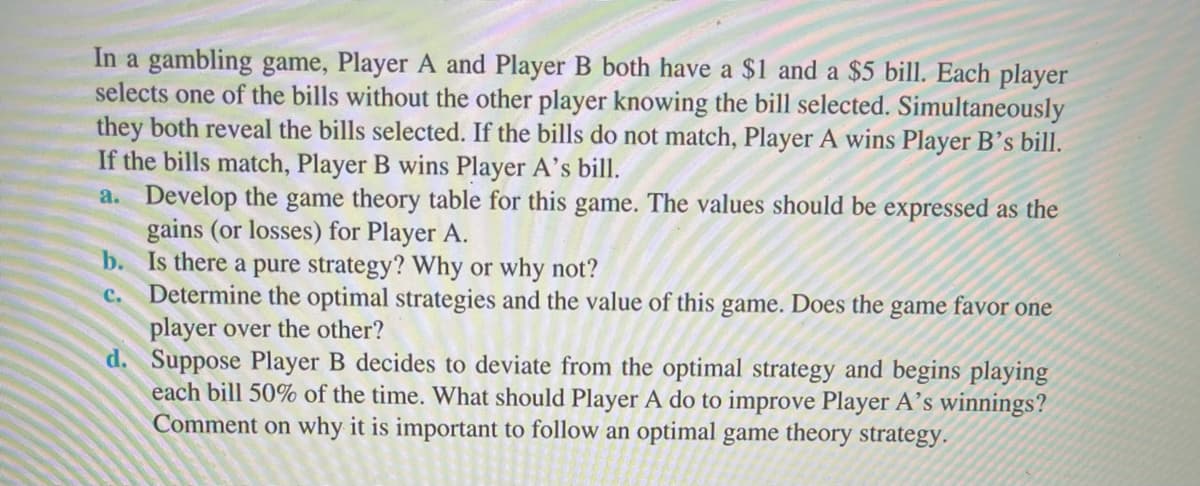In a gambling game, Player A and Player B both have a $1 and a $5 bill. Each player selects one of the bills without the other player knowing the bill selected. Simultaneously they both reveal the bills selected. If the bills do not match, Player A wins Player B's bill. If the bills match, Player B wins Player A's bill. a. Develop the game theory table for this game. The values should be expressed as the gains (or losses) for Player A. b. Is there a pure strategy? Why or why not? c. Determine the optimal strategies and the value of this game. Does the player over the other? d. Suppose Player B decides to deviate from the optimal strategy and begins playing each bill 50% of the time. What should Player A do to improve Player A’s winnings? Comment on why it is important to follow an optimal game theory strategy. game favor one
In a gambling game, Player A and Player B both have a $1 and a $5 bill. Each player selects one of the bills without the other player knowing the bill selected. Simultaneously they both reveal the bills selected. If the bills do not match, Player A wins Player B's bill. If the bills match, Player B wins Player A's bill. a. Develop the game theory table for this game. The values should be expressed as the gains (or losses) for Player A. b. Is there a pure strategy? Why or why not? c. Determine the optimal strategies and the value of this game. Does the player over the other? d. Suppose Player B decides to deviate from the optimal strategy and begins playing each bill 50% of the time. What should Player A do to improve Player A’s winnings? Comment on why it is important to follow an optimal game theory strategy. game favor one
Chapter8: Game Theory
Section: Chapter Questions
Problem 8.3P
Related questions
Question
100%

Transcribed Image Text:In a gambling game, Player A and Player B both have a $1 and a $5 bill. Each player
selects one of the bills without the other player knowing the bill selected. Simultaneously
they both reveal the bills selected. If the bills do not match, Player A wins Player B's bill.
If the bills match, Player B wins Player A's bill.
a. Develop the game theory table for this game. The values should be expressed as the
gains (or losses) for Player A.
b. Is there a pure strategy? Why or why not?
Determine the optimal strategies and the value of this game. Does the game favor one
player over the other?
d. Suppose Player B decides to deviate from the optimal strategy and begins playing
each bill 50% of the time. What should Player A do to improve Player A’s winnings?
Comment on why it is important to follow an optimal game theory strategy.
с.
Expert Solution
This question has been solved!
Explore an expertly crafted, step-by-step solution for a thorough understanding of key concepts.
This is a popular solution!
Trending now
This is a popular solution!
Step by step
Solved in 8 steps with 7 images

Knowledge Booster
Learn more about
Need a deep-dive on the concept behind this application? Look no further. Learn more about this topic, economics and related others by exploring similar questions and additional content below.Recommended textbooks for you


Principles of Economics (MindTap Course List)
Economics
ISBN:
9781305585126
Author:
N. Gregory Mankiw
Publisher:
Cengage Learning

Principles of Economics, 7th Edition (MindTap Cou…
Economics
ISBN:
9781285165875
Author:
N. Gregory Mankiw
Publisher:
Cengage Learning


Principles of Economics (MindTap Course List)
Economics
ISBN:
9781305585126
Author:
N. Gregory Mankiw
Publisher:
Cengage Learning

Principles of Economics, 7th Edition (MindTap Cou…
Economics
ISBN:
9781285165875
Author:
N. Gregory Mankiw
Publisher:
Cengage Learning

Principles of Microeconomics (MindTap Course List)
Economics
ISBN:
9781305971493
Author:
N. Gregory Mankiw
Publisher:
Cengage Learning

Managerial Economics: Applications, Strategies an…
Economics
ISBN:
9781305506381
Author:
James R. McGuigan, R. Charles Moyer, Frederick H.deB. Harris
Publisher:
Cengage Learning

Microeconomics: Principles & Policy
Economics
ISBN:
9781337794992
Author:
William J. Baumol, Alan S. Blinder, John L. Solow
Publisher:
Cengage Learning